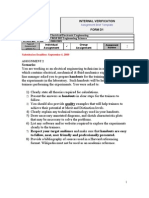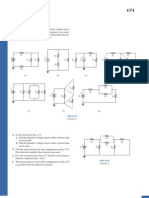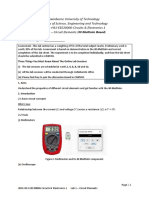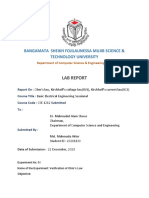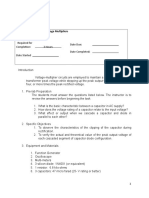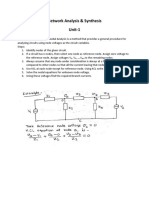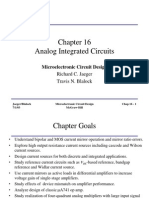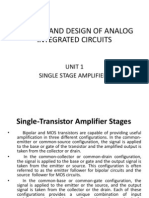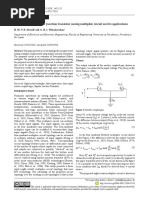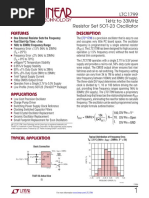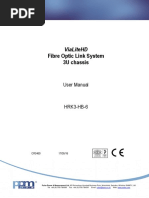Unit 4 - Network Theorems (Student)
Unit 4 - Network Theorems (Student)
Uploaded by
Kristine CruzCopyright:
Available Formats
Unit 4 - Network Theorems (Student)
Unit 4 - Network Theorems (Student)
Uploaded by
Kristine CruzCopyright
Available Formats
Share this document
Did you find this document useful?
Is this content inappropriate?
Copyright:
Available Formats
Unit 4 - Network Theorems (Student)
Unit 4 - Network Theorems (Student)
Uploaded by
Kristine CruzCopyright:
Available Formats
UNIT
NETWORK THEOREMS
4
LESSONS COVERED
1.1. Superposition Theorem
1.2. Thévenin ’s Theorem
1.3. Norton’s Theorem
1.4. Maximum Power Transfer Theorem
DURATION
6 hours
INTRODUCTION
In this module, the network theorems are introduced. As these are theorems, the
solutions to these rely on the application of methods or techniques presented in the
last two modules.
The focus of the theorems is on the output load or resistor.
The simplification of the network as viewed from the output side is a key characteristic
of these theorems.
OBJECTIVES/COMPETENCIES
At the end of the module, the students should be able to:
1. Recognize and analyze the different Network theorems for resistive
networks.
2. Apply combinations of Ohm’s Law, Kirchhoff’s Laws, VDF, CDF, Mesh and
Nodal Analyses to the solutions of Network Theorems.
3. Solve for voltages and currents as viewed from the load or output side of the
circuit.
4. Apply the Network theorem’s to other network theorems specifically on
maximum power transfer.
Unit 4: Network Theorems 84
PRETEST
Multiple Choice: Select the best answer by shading the appropriate box beside the
letter of the choices.
1. Which is the voltage of the 7Ω resistor?
A) 6.4 V C) 5.6 V
B) 2.4 V D) 3.8 V
2. Which is the current in the 3Ω resistor?
A) 1.8 A C) 1.7 A
B) 3.2 A D) 4.0 A
3. Which is the current in the 7Ω resistor?
A) 1.677 A C) 0.833 A
B) 1.167 A D) 0.333 A
4. Which is the current in the 5Ω resistor?
A) 0.50 A C) 6.545 A
B) 5.454 A D) 12.00 A
5. Which is the voltage in the 5Ω resistor?
A) 60 V C) 0.417 V
B) 2.4 V D) 72 V
Unit 4: Network Theorems 85
6. Which is the current in the 3Ω resistor?
A) 2.40 A C) 4.00 A
B) 0.65 A D) 0.80 A
7. Which is the voltage in the 7Ω resistor?
A) 12 V C) 3.0 V
B) 1.8 V D) 4.2 A
8. Which is the voltage in the 7Ω resistor?
A) 2.000 V C) 5.833 V
B) 1.167 V D) 4.200 V
9. Which is the power in the 5Ω resistor?
A) 28 W C) 20 W
B) 6.805 W D) 4.861 W
10. Which is the power in the 7Ω resistor?
A) 3.20 W C) 9.60 W
B) 4.48 W D) 1.92 W
Unit 4: Network Theorems 86
LESSON 4.1: SUPERPOSITION THEOREM
The Superposition Theorem
States
“The current through, or voltage across, any element of a network is equal to
the algebraic sum of the currents or voltages produced independently by each
source.” (Boylestad, 2016)
In the superposition theorem: initially one of the multiple sources is active while
the others are” turned off” and the circuit is analyzed with that active source. Then the
next source is active and the previous one is “turned off”.
In “turning off”: Voltage sources are replaced by a short circuit while current
sources are replaced by an open circuit.
Original Circuit:
Figure 1: A circuit with two voltage sources
Where:
I is the current in R2 due to V1 and V2
Steps:
1. “Turn off” alternately one of the sources in the circuit.
Part 1: Active Source: V1 Part 2: Active Source: V2
Figure 2: Alternately activating independently one source at a time
Where:
I1 is the current in R2 due to V1 only and I2 is the current in R2 due to V2 only
Unit 4: Network Theorems 87
2. Redraw Circuits when needed.
Part 1: Active Source: V1 Part 2: Active Source: V2
Figure 3: Circuits redrawn to adjust to the effect of the remnant source.
3. Solve for the current in each circuit. Any method is applicable, here Mesh Analysis
is used:
Part 1: Active Source: V1 Part 2: Active Source: V2
Figure 4: Circuits applied with Mesh Analysis
Get Mesh Equations
Mesh A: Mesh C:
–V1 + IAR1 + (IA – IB) R2 = 0 0 + ICR1 + (IC – ID) R2 = 0
Mesh B: Mesh D:
0 + IBR3 + (IB – IA) R2 = 0 +V2 + IDR3 + (ID – IC) R2 = 0
Solve for IA and IB Solve for IC and ID
Constraint Equation: Constraint Equation:
From Net Current: From Net Current:
I1 = IA – IB I2 = IC – ID
Part 3: Combine (Add) algebraically to get the resultant current.
I = I1 + I2
Unit 4: Network Theorems 88
APPLICATION
Sample 1: Solve for the current in each
resistor using superposition
Please note that the current directions are
all assumptions.
Solution:
Part 1: Consider only 10V source, shorting
7V source:
To distinguish the currents from the original:
the currents are marked with ( ‘ ) for the first
source.
Let’s apply KCL and KVL here:
KCL at middle upper node: I’2 + I’3 = I’1 (eq’n. 1)
CW direction KVL at left loop: CW direction KVL at right loop:
–10V – I’2(5Ω) – I’1 (8Ω) = 0 0V – I’3 (12Ω) + I’2(5Ω) = 0
8I’1 + 5I’2 = –10 (eq’n. 2) 5I’2 – 12I’3 = 0 (eq’n. 3)
(eq’n. 1) in (eq’n. 2)
8(I’2 + I’3) + 5I’2 = –10 5I’2 – 12I’3 = 0 (eq’n. 3)
8I’2 + 8I’3 + 5I’2 = –10 13I’2 + 8I’3 = –10 (eq’n. 5)
13I’2 + 8I’3 = –10 (eq’n. 5) To equations, two unknown = SOLVABLE!!
Using the equation/function of the calculator: From KCL
I’2 = – 0.612 A I’1 =I’2 + I’3 = (– 0.612 A) + (– 0.255 A)
I’3= – 0.255 A I’1= – 0.867 A
Unit 4: Network Theorems 89
Part 2: Consider only 7V source, shorting 10V
source:
To distinguish the currents from the original and
the first source: the currents are marked with ( “ )
for the second source.
Let’s also apply KCL and KVL here:
KCL at middle upper node: I”2 + I”3 = I”1 (eq’n. 1)
CW direction KVL at left loop: CW direction KVL at right loop:
– 7V – I”2(5Ω) – I”1 (8Ω) = 0 +7V – I”3 (12Ω) + I”2(5Ω) = 0
8I”1 + 5I”2 = – 7 (eq’n. 2) 5I”2 – 12I”3 = –7 (eq’n. 3)
(eq’n. 1) in (eq’n. 2)
8(I”2 + I”3) + 5I”2 = – 7 5I”2 – 12I”3 = –7 (eq’n. 3)
8I”2 + 8I”3 + 5I”2 = – 7 13I”2 + 8I”3 = –7 (eq’n. 5)
13I”2 + 8I”3 = – 7 (eq’n. 5) To equations, two unknown = SOLVABLE!!
Using the equation/function of calculator: From KCL
I”2 = – 0.714 A I”1 =I”2 + I”3 = – 0.714 + 0.286 A
I”3= +0.286 A I”1= – 0.428 A
Part 3: Combine (Add) algebraically to get the resultant current.
I1 = I’1 + I”1 = – 0.867 A – 0.428 A = – 1.295 A
I2 = I’2 + I”2 = – 0.612 A – 0.714 A = – 1.326 A
I3 = I’3 + I”3 = – 0.255 A +0.286 A = + 0.031 A
Those values with negative signs meant that the assumed direction of the current in
the given, should be pointing in the opposite direction:
For summary just provide the absolute values of the current as final answers:
I1 = 1.295 A
I2 = 1.326 A
I3 = 0.031 A
Unit 4: Network Theorems 90
Sample 2: Solve for the voltage in the 4Ω resistor using superposition theorem.
Solution:
Part 1: Consider only 20 V source, open the 5 A current source:
I’T
The circuit is redrawn as seen at the right as a series circuit.
Via Mesh Analysis:
+20 + I’T (5Ω + 8Ω + 4Ω) = 0 V’4Ω = I’T (4Ω)
17I’T = – 20 V’4Ω = (– 1.176 A) (4Ω)
I’T = – 1.176 A V’4Ω = – 4.705 V
Part 2: Consider only 5 A source, short the 20 V voltage source:
I”X
The circuit is redrawn as seen at the right as a simple series-parallel circuit.
Ohm’s Law
V”4Ω = I”X (4Ω)
Via CDF to get I”X , the current at the parallel branch that has the 8Ω and 4Ω resistors.
Recall CDF: Particular to this circuit:
𝐈𝐓 𝐑 𝐏𝐍 𝐈"𝐓 𝐑 𝟓Ω (𝟓𝑨)(𝟓Ω)
𝐈𝐍 = 𝐈"𝐗 = = = 1.471 A
𝐑𝐒 𝐑"𝐒 (𝟏𝟕Ω)
R”S = 5Ω +( 8Ω + 4Ω) = 17Ω V”4Ω = I”X (4Ω)
I”T = 5 A V’4Ω = (1.471 A) (4Ω)
V’4Ω = +5.884 V
Unit 4: Network Theorems 91
Part 3: Combine (Add) algebraically to get the resultant voltage.
V4Ω = V’4Ω + V”4Ω = –4.705 V +5.884 V
V4Ω = 1.179 V
ACTIVITY 1:
Using superposition, find the current through 2.2kΩ for the network:
Note: Original is from: (Boylestad, 2016) p 420 prob. 7
Unit 4: Network Theorems 92
LESSON 4.2: THÉVENIN’S THEOREM
Thévenin’s Theorem
States:
“Any two-terminal dc network can be replaced by an equivalent circuit
consisting solely of a voltage source and a series resistor” (Boylestad, 2016)
Core Concept of Thévenin’s Theorem
Figure 5: Two Terminal DC Network transformed to the Thévenin’s Equivalent Model
Thévenin’s Theorem Procedure*
Preliminary:
1. Remove that portion of the network where the
Thévenin equivalent circuit is found. This requires
that the load resistor “RL” be temporarily
removed from the network.
2. Mark the terminals of the remaining two-
terminal network.
RTH: Thévenin’s Equivalent Series Resistance as
seen from the load
3. Calculate RTH by first setting all sources to zero
(voltage sources are replaced by short circuits
and current sources by open circuits) and then
finding the resultant resistance between the two
marked terminals. (If the internal resistance of the
voltage and/or current sources is included in the original network, it must remain
when the sources are set to zero.)
VTH: Thévenin’s Open-circuit Voltage
4. Calculate VTH by first returning all sources to
their original position and finding the open-
circuit voltage between the marked terminals.
(This is the open-circuit voltage between the
two terminals marked in step 2.)
Conclusion:
Unit 4: Network Theorems 93
5. Draw the Thévenin equivalent circuit with the
portion of the circuit previously removed replaced
between the terminals of the equivalent circuit.
his step is indicated by the placement of the
resistor “RL” between the terminals of the Thévenin
equivalent circuit
* (Boylestad, 2016)
APPLICATION
Sample 3: Solve for the voltage in the 12Ω
resistor using Thévenin’s Theorem
Solution:
Thévenin’s Theorem:
Preliminary:
RTH:
Set all current sources as open circuit
and all voltage sources as short-circuit.
Determine resistance as seen from the RTH
RL side
RTH is 5Ω in parallel with 8Ω
(5Ω)(8Ω)
RTH = =3.077 Ω
5Ω+8Ω
VTH:
Return all sources back and solve for VTH
Use Mesh Analysis: +
– 10V – 7V + I (8Ω + 5Ω) = 0
– 17 + 13I = 0 VTH
I
13I = 17
I = 𝟏𝟕⁄𝟑 A
–
Unit 4: Network Theorems 94
Via Parallel Voltages:
VTH = –7V + (𝟏𝟕⁄𝟑 𝐀)(5 Ω)
VTH = – 0.462 V
Conclusion:
RTH = 3.077 Ω
+
VTH = – 0.462 V RTH = 3.077 Ω
VL
– –
VTH = 0.462 V VL = 0.368 V
+
Circuit redrawn with corrected polarity:
LESSON 4.3: NORTON’S THEOREM
Norton’s Theorem
States:
“Any two-terminal linear bilateral dc network can be replaced by an equivalent
circuit consisting of a current source and a parallel resistor” (Boylestad, 2016)
Core Concept of Norton’s Theorem
Figure 6: Two Terminal DC Network transformed to the Norton’s Equivalent Model
Norton’s Theorem Procedure*
Preliminary:
1. Remove that portion of the network across which
the Norton
equivalent circuit is found.
2. Mark the terminals of the remaining two-terminal
network.
Unit 4: Network Theorems 95
RN: Norton’s Equivalent Parallel Resistance as seen from the load
3. Calculate RN by first setting all sources to zero
(voltage sources are replaced with short circuits
and current sources with open circuits) and then
finding the resultant resistance between the two
marked terminals. (If the internal resistance of the
voltage and/or current sources is included in the
original network, it must remain when the sources
are set to zero.) Since RN = RTH, the procedure and
value obtained using the approach described for Thévenin’s theorem will determine
the proper value of RN.
IN: Norton’s Short-circuit Current
4. Calculate IN by first returning all sources to their
original position and then finding the short-circuit
current between the marked terminals.
It is the same current that would be measured by an
ammeter placed between the marked terminals.
Conclusion:
5. Draw the Norton equivalent circuit with the
portion of the circuit previously removed
replaced between the terminals of the
equivalent circuit.
* (Boylestad, 2016)
APPLICATION
Sample 4: Solve for the voltage in
the 4Ω resistor using Norton’s
theorem.
Solution:
Preliminary:
Unit 4: Network Theorems 96
RN:
Set all current sources as open circuit
And all voltage sources as short-circuit.
Determine resistance as seen from the
RL side
RN is 8Ω in series with 5Ω
RN = 𝟖Ω + 𝟓Ω = 13 Ω
RN
IN:
Return all sources back, short
the load terminal and solve for IN
Mesh 1: IN
I1 = + 5A I1 I2
Mesh 2: RN
20V + I2(8Ω) + (I2 – I1)(5Ω) = 0
20 + 8I2 + 5I2 – 5I1 = 0
20 + 13I2 – 5(5) = 0 Looking at Mesh 2, it is visible that:
13I2 – 5 = 0 IN = I2
I2 = 𝟓⁄𝟏𝟑 A = 0.385 A IN = 0.385 A
Conclusion:
IN = 0.385 A RN = 13 Ω
Solving for VL
IL
+
VL
IN = 0.385 A RN = 13 Ω
–
Solving IL by CDF:
𝐈𝐍 𝐑 𝐍 (𝟎.𝟑𝟖𝟓𝑨)(𝟏𝟑Ω)
𝐈𝐋 = = = 𝟎. 𝟐𝟗𝟒 𝑨
(𝐑 𝐍 +𝐑 𝐋 ) (𝟏𝟑Ω+𝟒Ω)
Unit 4: Network Theorems 97
APPLICATION
Conversion of the Equivalent Circuits:
During simplification of the circuit to Thévenin’s equivalent circuit, you might
end up with an open circuit similar to a Norton’s equivalent circuit and vice versa.
In some instances, circuits can be easily simplified to the other equivalent circuit
rather than what you were originally targeting for.
Below is the conversion scheme for these two equivalent circuits.
A. Thévenin’s to Norton’s
RN = RTh
IN=VTh/RTh
B. Norton’s to Thévenin’s
RTh = RN
VTh=INRN
ACTIVITY 2:
Given the following circuit:
a) Solve for the Thévenin’s Equivalent Circuit then convert it to its Norton’s Equivalent
Circuit.
b) Determine the power to the load, if the load resistance is:
b.1) 30Ω; b.2) 60Ω
Unit 4: Network Theorems 98
LESSON 4.4: MAXIMUM POWER TRANSFER THEOREM
Maximum Power Transfer Theorem
In circuit designs, the load should be able to maximize the input voltage and
current and in effect the power provide by the source. The input power should be
efficiently received by the load.
The maximum power theorem (MPT) states that in order for a load to “receive
maximum power from a network when its resistance is exactly equal to the Thévenin
resistance of the network” (Boylestad, 2016)
At MPT :
RL = RTH
Figure 7:: Thevenin's Equivalent for Maximum Power Transfer Conditions
Load Current “𝐈𝐋 ”, Load Voltage “𝐕𝐋 ” and Load Power “𝐏𝐋 ”
a. General Condition:
𝐕𝐓𝐡 𝐕𝐓𝐡 𝐑 𝐓𝐡
𝐈𝐋 = ; 𝐕𝐋 =
𝐑 𝐓𝐡 + 𝐑 𝐋 𝐑 𝐓𝐡 + 𝐑 𝐋
𝐕𝐓𝐡 𝐕𝐓𝐡 𝐑 𝐓𝐡
PL = IL VL = ( )( )
𝐑 𝐓𝐡 + 𝐑 𝐋 𝐑 𝐓𝐡 + 𝐑 𝐋
𝐕𝐓𝐡 𝟐 𝐑 𝐓𝐡
𝐏𝐋 =
(𝐑 𝐓𝐡 + 𝐑 𝐋 )𝟐
b. At MPT:
𝐕𝐓𝐡 𝐕𝐓𝐡 𝐑 𝐓𝐡
𝐈𝐋𝐌 = ; 𝐕𝐋𝐌 =
𝐑 𝐓𝐡 + 𝐑 𝐓𝐡 𝐑 𝐓𝐡 + 𝐑 𝐓𝐡
𝐕𝐓𝐡 𝐕𝐓𝐡
𝐈𝐋𝐌 = ; 𝐕𝐋𝐌 =
𝟐𝐑𝐓𝐡 𝟐
V V
Substitute to the Power Equation: PL = IL VL = (2RTh ) ( 2Th )
Th
𝟐
𝐕𝐓𝐡
𝐏𝐌𝐏𝐓 =
𝟒𝐑𝐓𝐡
Unit 4: Network Theorems 99
Power Efficiency (Ꞃ): Ratio or percentage of the Power consumed by the load to the
total power delivered to the system or entire circuit.
a. General Condition:
In Decimal form: In Percentage:
Ꞃ = PLoad/PTotal Ꞃ% = Ꞃ*100%
[𝐈𝐋𝟐 𝐑 𝐋 ]
Ꞃ=
[𝐈𝐋𝟐 (𝐑 𝐓𝐡 + 𝐑 𝐋 )]
𝐑𝐋
Ꞃ=
𝐑𝐓𝐡 + 𝐑𝐋
b. At Maximum Power: 𝐑 𝐓𝐡 = 𝐑 𝐋
𝐑𝐓𝐡
Ꞃ= = 𝟎. 𝟓
𝐑𝐓𝐡 + 𝐑𝐓𝐡
Or Ꞃ% = 50%
Load Resistance from Power Efficiency (Ꞃ) and R TH:
From: We Derive:
𝐑𝐋 Ꞃ𝐑𝐓𝐡
Ꞃ= ; 𝐑𝐋 =
𝐑𝐓𝐡 + 𝐑𝐋 𝟏−Ꞃ
APPLICATION
Sample 5: Determine the appropriate load resistance and current for the given
required Thévenin’s equivalent circuit with VTH of 8V and RTH of 12Ω to have a power
efficiency (Ꞃ%) of:
(a) 35% ; (b) 50% and (c) 95%.
Solution: = 12Ω
(a) RL for Ꞃ% = 35%
Ꞃ = 0.35
Ꞃ𝐑 𝐓𝐡 (𝟎. 𝟑𝟓)(𝟏𝟐Ω)
𝐑𝐋 = =
𝟏−Ꞃ (𝟏 − 𝟎. 𝟑𝟓)
𝐑 𝐋 = 𝟔. 𝟒𝟔𝟐 Ω
𝐕𝐓𝐡 𝟖
𝐈𝐋 = =
𝐑 𝐓𝐡 + 𝐑 𝐋 𝟏𝟐 + 𝟔. 𝟒𝟔𝟐
𝐈𝐋 = 𝟎. 𝟒𝟑𝟑 𝐀
Unit 4: Network Theorems 100
(b) RL for Ꞃ% = 50% (c) RL for Ꞃ% = 95%
Ꞃ = 0.50 Ꞃ = 0.95
Ꞃ𝐑 𝐓𝐡 (𝟎. 𝟓)(𝟏𝟐Ω) Ꞃ𝐑 𝐓𝐡 (𝟎. 𝟗𝟓)(𝟏𝟐Ω)
𝐑𝐋 = = 𝐑𝐋 = =
𝟏−Ꞃ (𝟏 − 𝟎. 𝟓) 𝟏−Ꞃ (𝟏 − 𝟎. 𝟗𝟓)
𝐑 𝐋 = 𝟏𝟐 Ω 𝐑 𝐋 = 𝟐𝟐𝟖 Ω
𝐕𝐓𝐡 𝟖 𝐕𝐓𝐡 𝟖
𝐈𝐋 = = 𝐈𝐋 = =
𝐑 𝐓𝐡 + 𝐑 𝐋 𝟏𝟐 + 𝟏𝟐 𝐑 𝐓𝐡 + 𝐑 𝐋 𝟏𝟐 + 𝟐𝟐𝟖
𝐈𝐋 = 𝟎. 𝟑𝟑𝟑 𝐀 𝐈𝐋 = 𝟎. 𝟎𝟑𝟑 𝐀
From that last sample problems answers, mathematically an efficiency of 95%
is indeed impressive compared to that of 35% and 50%. But, in observing also the
current in each efficiency case, the higher current is at 35%, while the lowest current
is at 95%. How can these two observations on efficiency and current be consolidated?
Simulated Proof of MPT
Let VTH = 10V, RTH = 20Ω
and RL is variable from 5Ω to 30Ω
VTH RTH RL IL VL PL Remarks
10 20 5 0.4000 2.0000 0.8000 Initial
10 20 6 0.3846 2.3077 0.8876 Increasing Power
10 20 7 0.3704 2.5926 0.9602 Increasing Power
10 20 8 0.3571 2.8571 1.0204 Increasing Power
10 20 9 0.3448 3.1034 1.0702 Increasing Power
10 20 10 0.3333 3.3333 1.1111 Increasing Power
10 20 15 0.2857 4.2857 1.2245 Increasing Power
10 20 16 0.2778 4.4444 1.2346 Increasing Power
10 20 17 0.2703 4.5946 1.2418 Increasing Power
10 20 18 0.2632 4.7368 1.2465 Increasing Power
10 20 19 0.2564 4.8718 1.2492 Increasing Power
10 20 20 0.2500 5.0000 1.2500 Maximum Power
10 20 21 0.2439 5.1220 1.2493 Decreasing Power
10 20 22 0.2381 5.2381 1.2472 Decreasing Power
10 20 23 0.2326 5.3488 1.2439 Decreasing Power
10 20 24 0.2273 5.4545 1.2397 Decreasing Power
10 20 25 0.2222 5.5556 1.2346 Decreasing Power
10 20 30 0.2000 6.0000 1.2000 Decreasing Power
Unit 4: Network Theorems 101
APPLICATION
Sample 6: A 12V DC battery has an internal resistance of 0.8. Determine:
(a) the power delivered to a load of 20Ω.
(b) the maximum power that the supply can ideally provide.
Solution:
(a) VTH = 12V , RTH = 0.8Ω and RL = 20Ω
𝐕𝐓𝐡 𝟐 𝐑 𝐓𝐡 (𝟏𝟐)𝟐 (𝟎. 𝟖)
𝐏𝐋 = =
(𝐑 𝐓𝐡 + 𝐑 𝐋 )𝟐 (𝟐𝟎. 𝟖)𝟐
PL = 0.266 W
(b) For MPT ; RL = RTh = 0.8Ω
𝐕𝐓𝐡 𝟐 (𝟏𝟐)𝟐
𝐏𝐌𝐏𝐓 = = PMPT = 45 W
𝟒𝐑 𝐓𝐡 𝟒(𝟎.𝟖)
Sample 7: Given is the Norton’s
equivalent model, to be connected
to a load.
Determine the maximum power
transfer level possible.
Solution:
Convert first to Thévenin’s Equivalent Circuit:
RTh = RN = 10kΩ
VTh=INRN =(0.125A)( 10kΩ)
VTh=1.25 kV
For MPT RL = RTh = 10kΩ
2
VTh (1.25𝑘𝑉 )2
PMPT = =
4R Th 4(10𝑘Ω)
𝐏𝐌𝐏𝐓 = 𝟑𝟗. 𝟎𝟔𝟐𝟓 𝐖
Unit 4: Network Theorems 102
ACTIVITY 3:
Given the following circuit and determine
the:
a) Norton’s Equivalent Circuit
b) The value of RL for maximum power
transfer.
c) The Load’s: Current, Voltage and Power
at MPT:
Unit 4: Network Theorems 103
POST TEST
Multiple Choice: Select the best answer by shading the appropriate box beside the
letter of the choices.
1. Which is the voltage of the 3Ω resistor?
A) 1.2 V C) 1.8 V
B) 2.4 V D) 3.0 V
2. Which is the current in the 7Ω resistor?
A) 1.7 A C) 1.8 A
B) 3.0 A D) 4.2 A
3. Which is the current in the 5Ω resistor?
A) 1.677 A C) 0.833 A
B) 1.167 A D) 0.333 A
4. Which is the current in the 6Ω resistor?
A) 0.50 A C) 6.545 A
B) 5.454 A D) 12.00 A
5. Which is the voltage in the 5Ω resistor?
A) 60 V C) 0.417 V
B) 2.4 V D) 30 V
Unit 4: Network Theorems 104
6. Which is the current in the 5Ω resistor?
A) 2.40 A C) 4.00 A
B) 0.65 A D) 0.80 A
7. Which is the voltage in the 5Ω resistor?
A) 12 V C) 3.0 V
B) 1.8 V D) 4.2 A
8. Which is the voltage in the 5Ω resistor?
A) 2.000 V C) 5.833 V
B) 1.167 V D) 4.200 V
9. Which is the power in the 7Ω resistor?
A) 28 W C) 20 W
B) 6.805 W D) 4.861 W
10. Which is the power in the 5Ω resistor?
A) 3.20 W C) 9.60 W
B) 4.48 W D) 1.92 W
Unit 4: Network Theorems 105
GLOSSARY
EQUIVALENT CIRCUIT. A circuit whose behavior is identical to that of a more
complex circuit or device over a stated range of operating conditions.
THEOREM. In mathematics and logic, statement in words or symbols that can be
established by means of deductive logic; it differs from an axiom in that a proof is
required for its acceptance.
FINAL REQUIREMENT
For SOL/AOL: Online Quiz 4
For RPL: Collective Quiz by January 2021
SUGGESTED READINGS AND WEBSITES
Read on Materials about other Network Theorems:
1. Millman’s Theorem
2. Substitution Theorem
3. Reciprocity Theorem
Online videos for Lecture: Search for Network Theorems in the Channel
1. The Engineering Mindset
https://www.youtube.com/channel/UCk0fGHsCEzGig-rSzkfCjMw
2. Michel van Biezen electrical engineering
https://www.youtube.com/watch?v=s6hRPyjTx6k&list=PLX2gX-
ftPVXXAQHPsgcokk4aCHZUKFuho
3. Math and Science
https://www.youtube.com/watch?v=OGa_b26eK2c
REFERENCES
Bird, J. (2017). Electrical Circuit Theory and Technology (6th ed.). NY: Routledge
Taylor & Francis Group.
Boylestad, R. (2016). Introductory Circuit Analysis: Global Edition (13th ed.), Essex,
England, Pearson Education Limited.
Irwin, J. D. & Nelms, R.M. (2015), Basic Engineering Circuit Analysis, (11th ed.). John
Wiley & Sons
https://www.thefreedictionary.com/
Unit 4: Network Theorems 106
You might also like
- Electrical and Electronic Principles 1 Past Year Paper Set 2Document13 pagesElectrical and Electronic Principles 1 Past Year Paper Set 2DennyChiang63% (8)
- Electronic CircuitsDocument15 pagesElectronic CircuitsMichael John PedrasaNo ratings yet
- CH 2meshandnodeanalysis-Jameel23oct23Document30 pagesCH 2meshandnodeanalysis-Jameel23oct23Gorin GorinNo ratings yet
- Assignment CTDocument9 pagesAssignment CTdhinojahimeshNo ratings yet
- Basic Electricity Questions MSDocument12 pagesBasic Electricity Questions MSs.alqarni.personalNo ratings yet
- Naveen Lab 8ECaDocument10 pagesNaveen Lab 8ECaMuhammad HamzaNo ratings yet
- Homework Assignment 02 Question 1 (Short Takes), 2 Points Each. 1Document14 pagesHomework Assignment 02 Question 1 (Short Takes), 2 Points Each. 1WoodchuckNo ratings yet
- DC Exp 5 Student ManualDocument5 pagesDC Exp 5 Student ManualMuhammad ZayedNo ratings yet
- Eeen 211 Lab 3Document12 pagesEeen 211 Lab 3Njayam EntertainmentNo ratings yet
- Test 1 - Sept16 AnswerDocument5 pagesTest 1 - Sept16 AnswerFarah IzzatiNo ratings yet
- Scenario:: Internal Verification Form D1Document10 pagesScenario:: Internal Verification Form D1tanmoyr2001No ratings yet
- Berl1125 Elect CCT Lab1 23 GroupDocument8 pagesBerl1125 Elect CCT Lab1 23 Groupdh4smdndy6No ratings yet
- Problemas CH6 PDFDocument11 pagesProblemas CH6 PDFJuan227100% (1)
- Analysis of Simple Circuits With DC ExcitationDocument34 pagesAnalysis of Simple Circuits With DC Excitationshradhdha.hNo ratings yet
- BENG 3013 - Chapter 1 - DeltaDocument39 pagesBENG 3013 - Chapter 1 - DeltaWan MamatkNo ratings yet
- Circuit Lecture 3 - Network Topology and Kirchhoff S LawDocument21 pagesCircuit Lecture 3 - Network Topology and Kirchhoff S LawpuicolossaltitanNo ratings yet
- Assignment 1 For CircuitsDocument4 pagesAssignment 1 For CircuitsAmir EyniNo ratings yet
- EECE210 Spring2021 Chap+4Document55 pagesEECE210 Spring2021 Chap+4starboyNo ratings yet
- Chapter 1. Diodes and ApplicationsDocument51 pagesChapter 1. Diodes and ApplicationsAnh Ha Duy AnhNo ratings yet
- Voltage Divider Rule and Current Divider RuleDocument6 pagesVoltage Divider Rule and Current Divider Rulearowona.hamidNo ratings yet
- NetworkDocument31 pagesNetworkনাজমূলNo ratings yet
- Assignment 1Document11 pagesAssignment 1sitaswain67No ratings yet
- Principles of Electronic Communication Winter 2019 Question PaperDocument7 pagesPrinciples of Electronic Communication Winter 2019 Question PaperPRANAV CNo ratings yet
- Electric Circuits EE 3Document71 pagesElectric Circuits EE 3akshaypokale7777No ratings yet
- Lab 1 Circuit ElementsDocument8 pagesLab 1 Circuit ElementsDawood SulemanNo ratings yet
- Module6 - Maxwell Mesh Current and Nodal AnalysisDocument31 pagesModule6 - Maxwell Mesh Current and Nodal AnalysisLady Napisah Tanandato BantogNo ratings yet
- Elec209 1705355554569Document6 pagesElec209 1705355554569family7482pleaseNo ratings yet
- ALL SLID Muntaser Sh. Al-DabeDocument365 pagesALL SLID Muntaser Sh. Al-Dabeaz47az109z5No ratings yet
- DC Lab Exp 5Document15 pagesDC Lab Exp 5Sagor Saha100% (3)
- Homework Assignment 03 Question 1 (Short Takes), 2 Points Each Unless Otherwise Noted. 1Document14 pagesHomework Assignment 03 Question 1 (Short Takes), 2 Points Each Unless Otherwise Noted. 1WoodchuckNo ratings yet
- bt21R0718 p1 18 11 09rahulDocument30 pagesbt21R0718 p1 18 11 09rahulAnonymous nTxB1EPvNo ratings yet
- 6 - Chapter 5Document13 pages6 - Chapter 5AhmedNo ratings yet
- Lab 2Document7 pagesLab 2Anonymous mXQtQtxNo ratings yet
- Lecture 5 BEEDocument10 pagesLecture 5 BEEarchana.rosuNo ratings yet
- Basic Electrical EngineeringDocument3 pagesBasic Electrical EngineeringNikash SubediNo ratings yet
- DC-Lab Report 05Document9 pagesDC-Lab Report 05Shahriar Ahsan JohaNo ratings yet
- Full Marks: 50 Duration: 3 HoursDocument2 pagesFull Marks: 50 Duration: 3 HoursK JaiswalNo ratings yet
- Question Bank BeeDocument25 pagesQuestion Bank Beedhruv goraiNo ratings yet
- Basic Electrical Lab ReportDocument8 pagesBasic Electrical Lab Reportleon saifullahNo ratings yet
- EC21101 Basic Electronics ES 2018Document4 pagesEC21101 Basic Electronics ES 2018Santanu Kundu100% (1)
- 1 - ELC ALL Unit MCQDocument84 pages1 - ELC ALL Unit MCQmandar.linkedinNo ratings yet
- Mid 2020 SDocument11 pagesMid 2020 Samedpv56No ratings yet
- Homework IDocument4 pagesHomework Ikjmd092399No ratings yet
- OhmDocument21 pagesOhmVictor WuNo ratings yet
- Elec2091st Semester Exam Paper20222328129 - 1705355554570Document6 pagesElec2091st Semester Exam Paper20222328129 - 1705355554570family7482pleaseNo ratings yet
- Electronics Product Engineering Workshop (ECP307) Lab ReportDocument7 pagesElectronics Product Engineering Workshop (ECP307) Lab ReportAkash GanniNo ratings yet
- Tutorial 7-ElectronicsDocument5 pagesTutorial 7-ElectronicsBriana PalmerNo ratings yet
- Mutah University The Faculty of Engineering Mechanical Engineering DepartmentDocument32 pagesMutah University The Faculty of Engineering Mechanical Engineering Departmentgangstarvegas919No ratings yet
- Beeme Imp QuesDocument3 pagesBeeme Imp QuesJitheshNo ratings yet
- Exercise 1 CombinedDocument12 pagesExercise 1 CombinedAnonymous The HackerNo ratings yet
- EXP. 2-Voltage MultiplierDocument3 pagesEXP. 2-Voltage MultiplierJohn Ratilla100% (1)
- Dkk1352-Electrical Technology 21213Document7 pagesDkk1352-Electrical Technology 21213Kalterz UnionNo ratings yet
- NAS Unit-1Document22 pagesNAS Unit-1Harsh ChoudharyNo ratings yet
- XII Physics Set - II 2Document3 pagesXII Physics Set - II 2taherok786No ratings yet
- Electricity Review 1d AnswersDocument4 pagesElectricity Review 1d AnswersTanmeetNo ratings yet
- EE 230 - Analog Lab - 2021-22/I (Autumn) Experiment 4: Current Source, Current Mirror, and Differential PairDocument4 pagesEE 230 - Analog Lab - 2021-22/I (Autumn) Experiment 4: Current Source, Current Mirror, and Differential PairSruthiNo ratings yet
- Lec2 BranchCurrentDocument71 pagesLec2 BranchCurrentKuro ShiroNo ratings yet
- Sheet 2. Electric CurrentsDocument3 pagesSheet 2. Electric CurrentsKike Rubio MirallesNo ratings yet
- Anna University Examination Questions: EE6201-Circuit Theory NOV - 2015Document9 pagesAnna University Examination Questions: EE6201-Circuit Theory NOV - 2015Anonymous yO7rcec6vuNo ratings yet
- Electromagnetic Compatibility (EMC) Design and Test Case AnalysisFrom EverandElectromagnetic Compatibility (EMC) Design and Test Case AnalysisNo ratings yet
- 4.4 MOSFETS in IC CSA CGA Biasing and AmplificationDocument33 pages4.4 MOSFETS in IC CSA CGA Biasing and AmplificationKesani Venkat Narsimha ReddyNo ratings yet
- Zbus Thevenin Equivalent Circuit1Document14 pagesZbus Thevenin Equivalent Circuit1Falguni_29No ratings yet
- Analysis and Validation of A Real-Time AC Drive Simulator, 2004.Document10 pagesAnalysis and Validation of A Real-Time AC Drive Simulator, 2004.Ali H. NumanNo ratings yet
- Microstepping Motor Driver: I SpecificationsDocument8 pagesMicrostepping Motor Driver: I SpecificationsAbdo AbdoNo ratings yet
- Top221 227Document20 pagesTop221 227jiledarNo ratings yet
- Chap16-Analog Integrated CircuitsDocument55 pagesChap16-Analog Integrated CircuitsMạnh Cường TrầnNo ratings yet
- Hybrid Series Active Filter: TH TH TH THDocument40 pagesHybrid Series Active Filter: TH TH TH THQawl TayebNo ratings yet
- FSQ0565R, FSQ0765R Green-Mode Fairchild Power Switch (FPS™) For Quasi-Resonant OperationDocument0 pagesFSQ0565R, FSQ0765R Green-Mode Fairchild Power Switch (FPS™) For Quasi-Resonant Operationsontuyet82No ratings yet
- Cathodic Disbondment Test of Pipeline Coatings (Attached Cell Method)Document4 pagesCathodic Disbondment Test of Pipeline Coatings (Attached Cell Method)Fernando Berrospi GarayNo ratings yet
- 5ECA0 Class 3: Equivalent Circuits (CH 5)Document81 pages5ECA0 Class 3: Equivalent Circuits (CH 5)Lars ReijndersNo ratings yet
- Dual-Channel Synchronous DC/DC Step-Down Controller With 5V/3.3V LdosDocument23 pagesDual-Channel Synchronous DC/DC Step-Down Controller With 5V/3.3V LdoskiryanoffNo ratings yet
- Chapter 8 PDFDocument20 pagesChapter 8 PDFSudipto Sarker SuptoNo ratings yet
- Atlanta WorkshopDocument235 pagesAtlanta WorkshopGuilherme CustodioNo ratings yet
- PW466i Protective Relay Test Set BrochureDocument21 pagesPW466i Protective Relay Test Set Brochuresunil.limaye3168No ratings yet
- Lmx31X Precision Voltage-To-Frequency Converters: 1 Features 3 DescriptionDocument23 pagesLmx31X Precision Voltage-To-Frequency Converters: 1 Features 3 DescriptionJavierPariNo ratings yet
- 15,16 Equivalent Circuit and Shading - 31 AUG, 4 SEPDocument37 pages15,16 Equivalent Circuit and Shading - 31 AUG, 4 SEPgauravNo ratings yet
- Analysis and Design of Analog Integrated Circuits: Unit 1 Single Stage AmplifiersDocument58 pagesAnalysis and Design of Analog Integrated Circuits: Unit 1 Single Stage AmplifiersjeevithaNo ratings yet
- Co2 PDFDocument43 pagesCo2 PDFSrikanth chowdary SereddyNo ratings yet
- An Eight-Octant Bipolar Junction Transistor Analog Multiplier Circuit and Its ApplicationsDocument9 pagesAn Eight-Octant Bipolar Junction Transistor Analog Multiplier Circuit and Its ApplicationsTabark AlaamryNo ratings yet
- Lect05 PDFDocument15 pagesLect05 PDFVan GoldbergNo ratings yet
- SPICEDocument91 pagesSPICESiva YellampalliNo ratings yet
- 1HS01G PDFDocument18 pages1HS01G PDFAldo TonatoNo ratings yet
- Tle 8209Document41 pagesTle 8209Olga PlohotnichenkoNo ratings yet
- AD7533Document12 pagesAD7533Jose David Medina MartinezNo ratings yet
- Increase DESAT Charging Current E2E PublicDocument5 pagesIncrease DESAT Charging Current E2E PublicĐức Lương NguyễnNo ratings yet
- Features Description: Ltc1799 1Khz To 33Mhz Resistor Set Sot-23 OscillatorDocument14 pagesFeatures Description: Ltc1799 1Khz To 33Mhz Resistor Set Sot-23 OscillatorHưng HQNo ratings yet
- LM5022Document41 pagesLM5022email emailNo ratings yet
- Dependent Voltage and Current SourcesDocument8 pagesDependent Voltage and Current SourcescassNo ratings yet
- ViaLiteHD 3U Chassis Handbook HRK3 HB 6Document39 pagesViaLiteHD 3U Chassis Handbook HRK3 HB 6Lorenz Adriano RoblesNo ratings yet
- Rahmani Andebili2021Document235 pagesRahmani Andebili2021mihai nicolaeNo ratings yet










